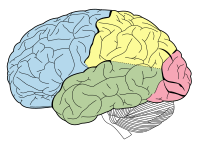
Photo from wikipedia
Abstract Due to the unstructured, fast-changing environment of construction sites, robots require human assistance to perform various tasks, especially those involving high dexterity and nuanced human judgment. However, in shared… Click to show full abstract
Abstract Due to the unstructured, fast-changing environment of construction sites, robots require human assistance to perform various tasks, especially those involving high dexterity and nuanced human judgment. However, in shared physical spaces, human-robot collaboration (HRC) can raise new safety concerns as workers' mental health can be adversely affected by poor communication between the two peers. To create a harmonized, safe HRC, this study proposes a worker-centered collaborative framework that enables robots to capture workers' brainwaves from wearable electroencephalograph, evaluate their task-related cognitive load, and adjust the robotic performance accordingly. The framework was examined by asking 14 subjects to execute a collaborative construction task with a terrestrial robot under various levels of cognitive loads. The results showed the robot could regulate its working pace with 81.91% accuracy. This level of communication can instill trust in HRC and facilitate future endeavors in safety design of collaborative robotics.
Journal Title: Automation in Construction
Year Published: 2021
Link to full text (if available)
Share on Social Media: Sign Up to like & get
recommendations!